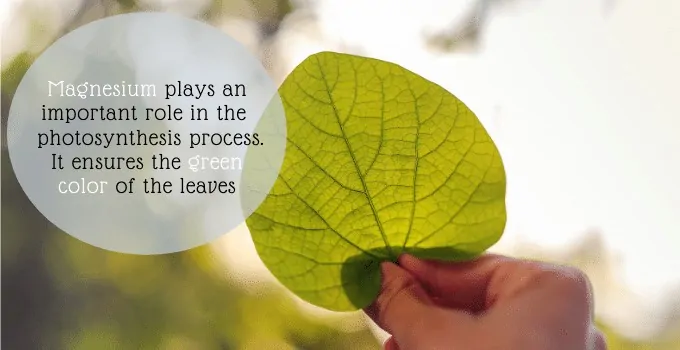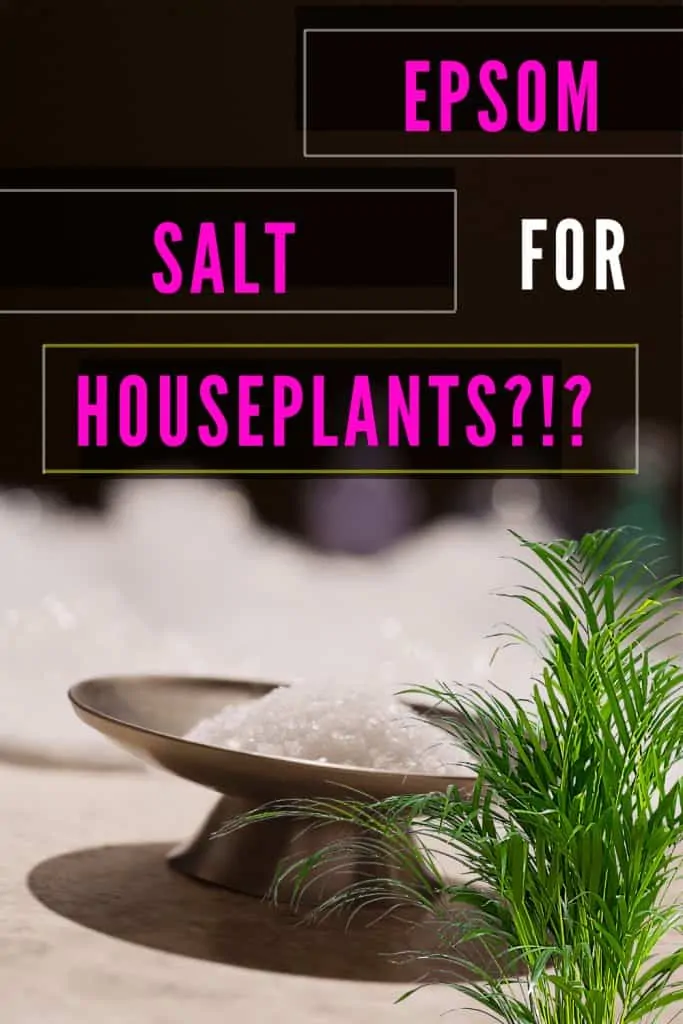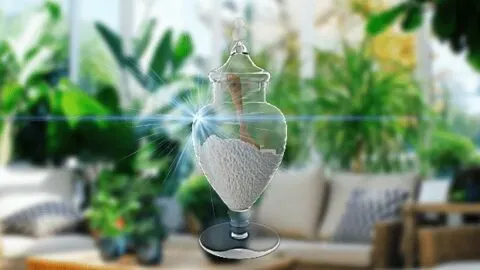You are here to know the answer to the question “Is Epsom Salt Good for Houseplants?” The answer is it depends. But generally, yes.
Table of Contents
Is Epsom Salt Good for Houseplants?
Epsom salt is good for houseplants. But not in every case. Magnesium and sulfur play an important role in keeping houseplants healthy. Epsom salt contains magnesium and sulfur and is useful for houseplants when they have a deficit in either or both of these nutrients.

Magnesium Deficiency in Your Houseplants
Epsom salt can be used as a fertilizer because Epsom salt contains magnesium.
Magnesium (mg) is essential for plant growth according to Minnesota University. It is an important fertilizer component because is it the core of the chlorophyll content. Without it plants do not grow well.
How to recognize magnesium deficiency in your houseplants
As magnesium deficiency is a detrimental plant disorder and will, in many cases, seriously harm your plant, it is important to know how to recognize such a deficiency in your houseplants.
Magnesium is an important macronutrient for your plant, and it is absolutely crucial to ensure healthy plant growth.
So how to find out if your plant suffers from a lack of magnesium now?
More often than not, the first sign of magnesium deficiency in houseplants is the loss of the normal green coloration of your houseplant leaves. This process is often called chlorosis.
So the main symptom of magnesium deficiency is actually yellowing between the veins of the leaves.
However, recognizing magnesium deficiency in plants is by no means easy, as other plant disorders and deficiencies display similar symptoms.
Simply put: Yellowing leaves could be due to various plant disorders; it does not necessarily mean that your plant is suffering from magnesium deficiency.

Epsom salt as a sulfur fertilizer
Not only can Epsom salt be used as a magnesium fertilizer but also as a sulfur fertilizer.
Sulfur, just as magnesium is an important element for healthy plant growth.
Luckily, our Epsom salt is both high in magnesium and also sulfur.
Recognizing sulfur deficiency in your houseplants
This is where things get a little bit complicated because sulfur deficiency displays very similar symptoms as magnesium and nitrogen deficiency.
So, if you are not an expert, you will want to keep a close eye on your houseplants and the development of these deficiencies to ensure that your identification of the problem is accurate.
Magnesium deficiency is signified by yellowing between the veins of the leaves.
Sulfur deficiency, on the other hand, can usually be recognized by a light green discoloration of the leaves.
It is important to note here that at the beginning stages of sulfur deficiency, the youngest leaves of your houseplant will be affected and will turn lighter in color, and only then, over time, the older leaves of the plant will exhibit a similar symptom, thus turning lighter in color as well (lighter green).
However, a sulfur deficiency is a process that exhibits many stages and, therefore, can only be detected properly if you regularly inspect your houseplants.
At the later stages, houseplants that suffer from sulfur deficiency will feature deep yellow leaves. So the leaves that once were lighter green will then be yellow.
And that can be confusing because, at this point, the symptoms resemble the symptoms of magnesium deficiency in houseplants.
Sulfur deficiency is significantly less common in plants compared to a magnesium deficiency.
And then there is also nitrogen deficiency, which, too, shows pretty similar symptoms to both sulfur deficiency and magnesium deficiency.
However, we are saving the topic of nitrogen deficiency for another article.
How do you administer Epsom salt to your Houseplants?
Epsom salt has the advantage that it is water-soluble.
You can, therefore, dilute Epsom salt with water and administer it to your plants in this way.
But how do you administer it properly?
A bulletproof way to supply your houseplants with Epsom salt is to add Epsom salt as a solution of about 25 grams (per liter) to the soil of your houseplant.
However, Epsom salt does not necessarily have to be diluted with water, as it can also be added directly into the soil.
However, you can also spray Epsom salt directly onto the leaves of your plant. To do so, just follow these simple steps here:
Spray it on the leaves of houseplants
- Dissolve one tablespoon of Epsom salt in one liter of water
- Pour the solution into a suitable spray bottle
- Then spray the leaves of your houseplants evenly
Using Epsom salt as a leaf fertilizer is definitely also a good option because the houseplants can also absorb and process the minerals in this way very well and, depending on the situation, even faster than by fertilizing the soil with Epson salt.
But Epsom salt is not the only way to treat magnesium deficiency in houseplants.
Other remedies include dolomitic limestone. Dolomitic limestone, just as Epson salt, can be added to the soil, just as Epsom salt.
What exactly happens when you use Epsom salt for your houseplants?
If your plants have a magnesium or sulfur deficiency and you are now administering Epsom salt, then you naturally want to ensure that this deficiency can be remedied.
But what exactly happens during this process?
If you administer Epsom salts to your plants or plant soil, this leads to a reduction in the pH value of the soil.
Now it is the case that your plants can only absorb this magnesium from the Epsom salts well if the pH value is within a certain range.
A low pH value is ideal (6 to 8 = perfect range).
However, the pH value must not be below 6 because then your plant can no longer absorb the magnesium at all, and you can then fertilize as much as you like, the plant will not receive the substance.
Okay. Now, we’ve got one question out of the way, but we’ve already provoked the next question.
How can I even check the pH value of the soil?
The pH value of the plant soil can easily be checked with a pH meter. You can plug this meter into the soil and then take the pH value from the meter.
You might want to go for a so-called soil meter. Many of these soil meters do offer a 3-in-1 functionality and will help you to maintain the right light, moisture, and pH levels.
Maintaining the right soil pH level is crucial for your houseplant. If the soil is either too acidic or alkaline, your plant might be in deep trouble and more at risk for certain pests & viruses.
Epsom salt in Universal Fertilizers
As described in detail in this article, Epsom salt can be used in a targeted manner precisely when there is a magnesium or sulfur deficiency in your houseplants.
However, you should also know that magnesium and sulfur are already an integral part of many universal fertilizers. The additional administration of Epsom salt may, therefore, not be necessary.
Where can you buy Epsom salt?
You can buy Epsom salt on Amazon. Here you will find Epsom salt in all sizes and varieties.
What else can Epsom salt be used for?
There are various applications for Epsom salt. This is not surprising, as it contains, as we have seen earlier, the important substances magnesium and sulfur. And these substances are not only needed by plants but also by humans.
Epsom salt is a true miracle cure for humans as well. For example, Epsom salts can treat skin blemishes on the face and the body.
An Epsom salts bath, on the other hand, can help with sore muscles because, thanks to magnesium, it helps you to relax.
But not only the magnesium of the Epsom salt works wonders because the sulfate can also have a positive effect on humans. It helps, for example, to stimulate the pancreas and thus helps to detoxify our body.
FAQ
Is Epsom salt the same as Magnesium Sulfate?
Absolutely. Magnesium sulfate is the chemical name of Epsom salt.
What nutrients does Epsom salt provide as a plant fertilizer?
As a plant fertilizer, Epsom salt provides the nutrients magnesium and sulfur—no more, but also no less.
What does the addition “USP” mean on Epsom salt products?
Whenever you find USP or USP grade on an Epsom salt product, you are dealing with a high-quality Epsom salt, namely an Epsom salt that meets or exceeds the requirements of the United States pHarmacopeia (USP).
What does magnesium do in houseplants?
Magnesium is an important building block for chlorophyll. Chlorophyll is a molecule that absorbs sunlight and uses its energy to synthesize carbohydrates from CO2 and water. This process is known as pHotosynthesis and is the basis for sustaining the life processes of all plants. Without going too much into detail here, it is also not wrong to say that magnesium helps to keep green plants, well, green.
How much does Epsom salt cost?
Epsom salt is pretty cheap. You can get a kilogram of Epsom salt for about 6 to 10 dollars.
Can I also use Epsom salt as fertilizer?
Epsom salt is used to combat magnesium or sulfur deficiency in plants specifically. The use of Epsom salt is, therefore, very one-sided. As a rule, you should also use regular houseplant fertilizer for your houseplants.
For which type of plants is Epsom salt particularly well suited?
Epsom salt is an excellent fertilizer for needle plants. But other plants such as tomatoes or peppers like Epsom salt also need a lot of magnesium to stay healthy and thrive.
Is Epsom salt for houseplants controversial?
That’s fair to say. While some plant lovers swear by Epsom salts and achieve good results with them, others advise against using Epsom salts for plants at all. Epsom salt is not without problems and can only lead to good results if used correctly and, above all, for the right purpose. And the right purpose means, first and foremost, that there must be a magnesium deficiency in the plant. And such a deficiency can often only be detected by a thorough soil analysis. The right dosage is not easy, either. And if too much Epsom salt is used, this can promote soil toxicity.
This was all you need to know about Epsom salt for houseplants and more. I use this salt frequently and my plants love it.

Daniel has been a plant enthusiast for over 20 years. He owns hundreds of houseplants and prepares for the chili growing seasons yearly with great anticipation. His favorite plants are plant species in the Araceae family, such as Monstera, Philodendron, and Anthurium. He also loves gardening and is growing hot peppers, tomatoes, and many more vegetables.


